Captain Wilson Avenue

Photograph of Captain Wilson Avenue street sign in Parkes, and DH5 A9449 aircraft that Captain Wilson flew in France during World War 1 Source: Google maps and Wings Palette website
Many historical and significant people can be found by reading the street names of the Parkes Shire. Road names such as ‘Church Street’ and ‘Railway Sreet’ indicate close proximity to important town fixtures. Most residents would be aware that ‘Clarinda Street’ was named after Sir Henry Parkes’ first wife, Lady Clarinda (née Varney) in 1887. The original name of Clarinda Street was ‘Forbes Street’, highlighting that roads can be renamed. However the street name historyparkes will focus on today isn’t named after a local resident. Captain Wilson Avenue is a short road that connects Close Street and Middleton Street. It originally was intended to be called ‘Canberra Street’ – with side streets being named Melbourne Street and Sydney Street. This post will look at who Captain Wilson was and why he was chosen to be honoured with a street named after him.

Map of section of Parkes, highlighting Captain Wilson Avenue. The thick yellow line to the right is the Newell Highway (aka Bogan Road). Source: Google Maps
Gordon Campbell Wilson was born on October 6, 1895 at Minmi, an outer western suburb of Newcastle, New South Wales. His parents were Scottish miner, William Wilson, and Tasmanian-born Agnes Cecilia (née Jackson). A student of public schools he then went on to Newcastle Technical College before becoming an apprentice patternmaker with the engineering firm A. Goninan & Co, Ltd. (Fraser 1990 from the Australian Dictionary of Biography website)
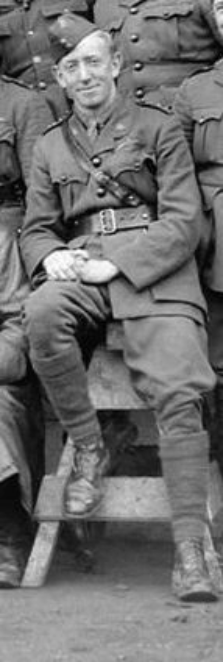
Photograph of Gordon Campbell Wilson, part of the Australian Flying Corps. Before this he also was a sapper. Source: Aussie Sappers website
Historian Alan Fraser details Wilson’s bravery and determination to serve his country during the Great War:
At the outbreak of World War I Wilson was a member of the 39th Fortress Company, Engineers, Australian Military Forces, and soon after transferred to the Australian Imperial Force. He embarked from Sydney as a lance corporal with the 1st Field Company, Engineers, in October. After training in Egypt, his unit was among the first to land at Gallipoli on 25 April 1915 and Wilson’s work in trench consolidation during that day’s desperate fighting came under special notice. Although wounded during the first month, he remained on duty, distinguishing himself in mining and trench construction, until relieved in November. He was mentioned in dispatches and later awarded the Distinguished Conduct Medal for his Gallipoli service and for his work as a section sergeant of the 5th Division, Engineers, particularly during the battle of Fromelles, France, in July 1916.

Photograph of Captain Gordon Campbell Wilson, in Australian Flying Corps uniform. Source: Newcastle City Council Regional Museum Database http://collections.ncc.nsw.gov.au/keemu/objects/common/webmedia.php?irn=52145&reftable=ecatalogue&refirn=48516
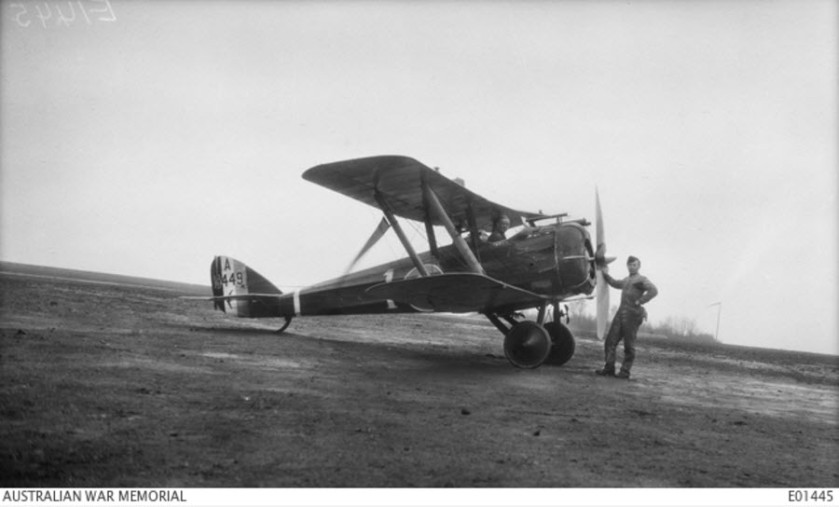
Captain G. C. Wilson MC DCM, near Baizieux, seated in an D.H.5 A9449, ‘1’ aircraft with which he did effective bombing and harassing work during the Cambrai Battle of November 1917, thereby earning for himself the Military Cross. Standing near the propeller is 2348 1st Air Mechanic Henry Alexander Momsen. The white band round the fuselage was, at the time the photograph was taken, the official Squadron marking. Source: Australian War Memorial website
While experiencing war at both Gallipoli and in France would be more than enough for most soldiers, Wilson had not finished contributing to the war effort just yet. The amazing feats and accolades for this inspirational man continued:
Transferring to the Australian Flying Corps in December, Wilson was commissioned as a second lieutenant, A.F.C., in April 1917 and graduated as a pilot. In June he joined No.68 Squadron (later designated the 2nd Squadron) A.F.C., and flew De Havilland 5 aircraft. With other pilots of the three new A.F.C. squadrons soon to mobilize for overseas service, he was detached to a Royal Flying Corps squadron in France to gain practical experience in war flying. Wilson joined No.32 Squadron, R.F.C., in late July, but was wounded while carrying out low-level strafing during the 3rd battle of Ypres, Belgium. Rejoining his squadron in England, he was appointed flight commander, promoted captain and accompanied the squadron to France in September. Equipped with aeroplanes inferior in performance and armament to enemy fighters, the squadron received special training in ground attack and played an important part—though with heavy casualties—in the battle of Cambrai in November: no fewer than six squadron pilots, among them Wilson, were awarded the Military Cross on the same day for their difficult and dangerous low-level bombing and strafing in support of ground operations. Clashes with the Germans were frequent and Wilson was credited with the destruction of one enemy aircraft which he shot down and then blew to pieces with a bomb.
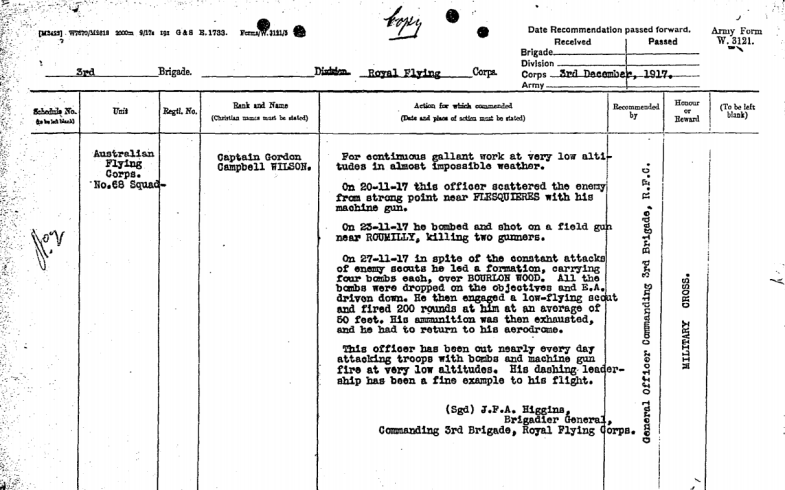
Captain Wilson’s recommendation for a Military Cross, highlighting his gallantry and skill as a pilot for the Australian Flying Corps. Source: Australian War Memorial website
According to information found on the Australian War Memorial website, Captain Wilson is held in the highest esteem amongst British and Commonwealth war heroes.
Of the many decorated members of the Australian Flying Corps only one , Capt G.C. Wilson had the the great distinction of having been awarded the Military Cross, Air Force Cross, Distinguished Conduct Medal, and Mentioned in Despatches. The combination of decorations is unique to an Australian and is not known to any other member of the British or Commmonwealth Forces.
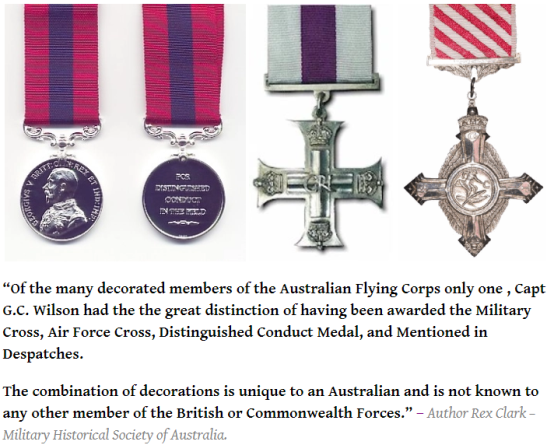
Captain Wilson was highly decorated, the only member of the British or Commonwealth Forces to have the great distinction of being awarded the Military Cross, Air Force Cross, Distinguished Conduct Medal, and Mentioned in Despatches. Source: Aussie Sappers website
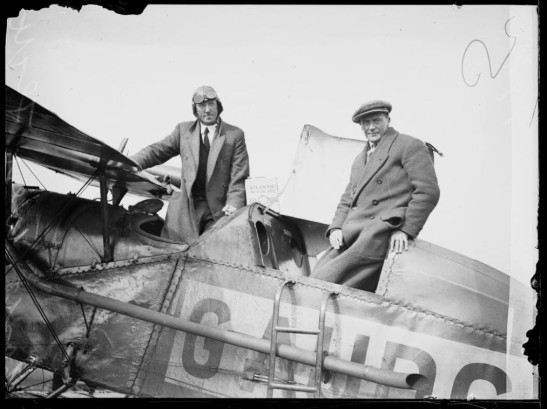
- Aviators Captain Gordon Wilson and Frank Buchan in their Bristol Tourer at Mascot, Sydney, 1928 from a Fairfax archive of glass plate negatives. Source: Trove
After serving his country with distinction, Captain Wilson returned to civilian life still working in aviation. However the lack of government support meant “…many of the post-war aviation ventures failed…” even with Wilson’s association with Charles Ulm
Although his appointment with the Australian Imperial Force had finished in July, in September 1919 Wilson flew and landed in Parkes. He and his flying companion, Percy McNamara, were raising funds for the Peace Loan. This was an apolitical appeal project to support soldiers who were returning to civilian life. Those who were maimed were to be retrained in order to find a new occupation. Men in good health were to be assisted in receiving the benefits that they would have received had war not interrupted their careers. According to local newspaper reports, the Central West had been touched by Captain Wilson’s words as much as his flying expertise. Wilson’s flying tour had raised the following amounts:
Dubbo £9,000
Mudgee £8,000
Cumnock £8,000
Narromine £13,000
Gulgong £8,000
Molong £500
Peak Hill £6,000
Parkes £3,000
Western Champion September 25, 1919 page 5

Excerpt from newspaper report about the great anticipation of the large crowd awaiting Captain Wilson’s arrival by air at Parkes. To read the full article click here. Source: Western Champion Thursday 25 September 1919 page 5

Captain Wilson also made special flights to Trundle, Bogan Gate, Tullamore and Tottenham. This excerpt higlights the Trundle trip. To read the full article click here. Source: Western Champion Thursday June 9, 1921 p.13
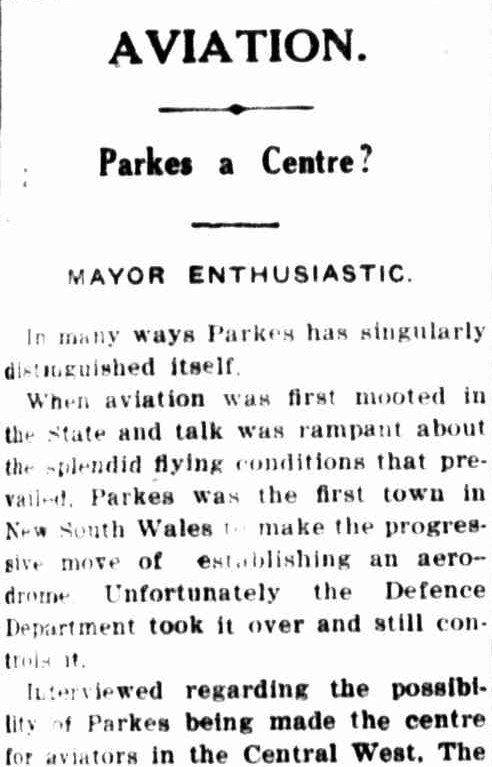
So enamored with Captain Wilson’s exploits, that Mayor Ald. Spicer wanted to Parkes to be the first town in New South Wales with an aerodrome. Captain Wilson offered advice and data. Source: Western Champion Thursday August 9, 1928 p.13
Tragically, Captain Wilson was killed while travelling through Bogan Gate. He was under employment of New South Wales Airways Ltd. Wilson’s two travelling companions – driver Mr M A Taylor and Mr N Bloomfield survived the accident with minimal injuries – Taylor had a broken wrist but was spared more serious injuries due the car being fitted with a flexible wheel. Bloomfield, sitting in the middle, only received a few scratches. All three were sitting in the front seat. It is believed that at the time of his death, Captain Wilson was engaged to be married. Captain Wilson had returned to Parkes, staying for about a week and renewing the town’s relationship with the heroic soldier. He was popular when recognised and as a result of his work aircraft rose in popularity among the general public.
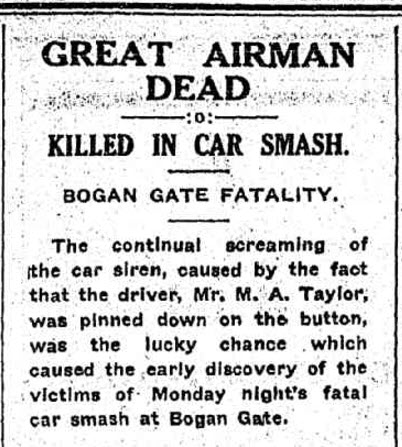
Newspaper reporting the tragic death of Captain Wilson whilst driving through Bogan Gate. To read the full article click here. Source: Western Champion Thursday 14 March, 1929 page 13

Scanned excerpt from Parkes Municipal Council minutes, highlighting that Captain Wilson Avenue would become one of the street names of Parkes. Source: Parkes Municipal Council Meeting Minutes April 12th, 1929
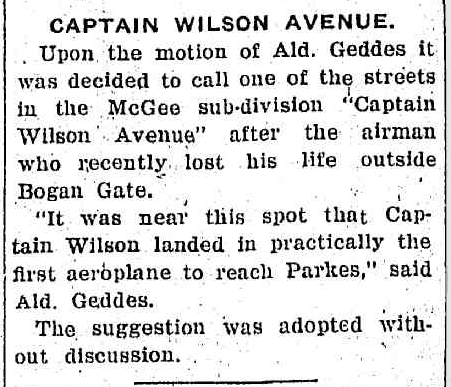
The local newspaper mentioned that Parkes wanted to honour Captain Wilson by naming one of the streets in a new sub-division ‘Captain Wilson Avenue’. Source: Western Champion Monday 15 April, 1929 p.12

Captain Wilson’s death had a profound effect on the people of Parkes. He was given semi-military honours through the town, eight returned soldiers acted as pallbearers, with all traffic The Town Band marched ahead of the hearse, along with 40 ex-servicemen, the Mayor, Town Clerk and other dignitaries. Source: The Wingham Chronicle and Manning River Observer Friday May 24, 1929 p.2
Parkes Shire Library would like to thank the following people and organisations for their assistance with this blog post:
- David Nash;
- Ed Tonks;
- Australian War Memorial website;
- Trove;
- Parkes Champion Post.
If you have stories or memories that you are willing to share about Captain Gordon Campbell Wilson and/or Captain Wilson Avenue please contact Parkes Shire Library via dan.fredericks@parkes.nsw.gov.au so that they can be shared and kept for posterity on this blog. Alternatively you may leave comments on this page.
REFERENCE LIST
- Street Sign[Photograph found in Google Maps]. (2010, February). Retrieved August 17, 2017, from https://www.google.com.au/maps/@-33.1375597,148.166199,3a,25.4y,29.63h,84.11t/data=!3m6!1e1!3m4!1sCCUI-w_rH8mTaRLz80S-mw!2e0!7i13312!8i6656
- DH5 A9449 [Digital image]. (2013, April 5). Retrieved August 18, 2017, from http://wp.scn.ru/en/ww1/f/535/81/0
- 110 Gordon Campbell Wilson. (n.d.). photograph. Retrieved February 20, 2020, from https://aussiesappers.wordpress.com/2015/05/31/captain-gordon-wilson-mc-afc-dcm-mid/
- Military Cross Recommendation (December 3, 1917). Retrieved February 20, 2020, from https://s3-ap-southeast-2.amazonaws.com/awm-media/collection/RCDIG1068780/document/5517112.PDF
- Alan Fraser, ‘Wilson, Gordon Campbell (1895–1929)’, Australian Dictionary of Biography, National Centre of Biography, Australian National University, http://adb.anu.edu.au/biography/wilson-gordon-campbell-9136/text16117, published first in hardcopy 1990, accessed online 17 August 2017.
- Captain Wilson [Photograph found in Hunter World War One Diggers, Newcastle Regional Museum, Newcastle]. (2003). In Digger: Gordon Campbell Wilson 110. Newcastle, NSW: Newcastle City Council. Retrieved August 17, 2017, from http://collections.ncc.nsw.gov.au/keemu/objects/common/webmedia.php?irn=52145&reftable=ecatalogue&refirn=48516
- Unknown Australian Official Photographer. (n.d.). Captain G C Wilson MC DCM [Photograph found in Australian War Memorial, Campbell, ACT]. Retrieved August 17, 2017, from https://www.awm.gov.au/collection/C46058?image=1 (Originally photographed 1917, December 1)
- NEW STREETS. (1929, January 31). Western Champion (Parkes, NSW : 1898 – 1934), p. 11. Retrieved August 17, 2017, from http://nla.gov.au/nla.news-article113459466
- Clark, Rex. “Captain G.C. Wilson, MC, AFC, DCM, MID / by Rex Clark.” The Australian War Memorial, www.awm.gov.au/collection/LIB100011369. Accessed 18 Aug. 2017.
- Fairfax Corporation. (1928). Aviators Captain Gordan Wilson and Frank Buchan in their Bristol Tourer at Mascot, Sydney, 1928 Retrieved August 18, 2017, from http://nla.gov.au/nla.obj-162119457
- PEACE LOAN (1919, September 25). Western Champion (Parkes, NSW : 1898 – 1934), p. 5. Retrieved August 18, 2017, from http://nla.gov.au/nla.news-article113457777
- TRUNDLE. (June 9, 1921). Western Champion (Parkes, NSW : 1898 – 1934), p. 13. Retrieved February 24, 2020, from http://nla.gov.au/nla.news-article113520065
- AVIATION. (August 9, 1928). Western Champion (Parkes, NSW : 1898 – 1934), p. 13. Retrieved February 24, 2020, from http://nla.gov.au/nla.news-article113532937
- GREAT AIRMAN DEAD (1929, March 14). Western Champion (Parkes, NSW : 1898 – 1934), p. 13. Retrieved August 18, 2017, from http://nla.gov.au/nla.news-article113460746
- “Captain Wilson Avenue” Parkes Municipal Council Meeting Minutes April 12th, 1929
- FLIERS FUND. (April 15, 1929). Western Champion (Parkes, NSW : 1898 – 1934), p. 12. Retrieved February 24, 2020, from http://nla.gov.au/nla.news-article113461493
- Great Airman Dead (May 24, 1929). The Wingham Chronicle and Manning River Observer (NSW : 1898 – 1954), p. 2. Retrieved February 24, 2020, from http://nla.gov.au/nla.news-article166904549
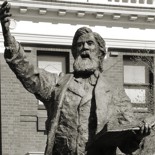
My name is Ed Tonks and I have been researching GCW for more than 30 years. Happy to share my material if you are interested. If you have a chance give me a call on my mobile on 0413484702. Out of interest a few points in this blog are not quite accurate. Hopefully you will be in touch. Very pleased that you are keeping GCW’s memory alive.
LikeLike
Hi Ed,
Thank you for reading our blog and contacting us. I would be very interested to discuss GCW with you and will give you a call on Monday as presently I am the sole staff worker on a Saturday. Thanks again for contacting us.
LikeLike
Dan Fredericks. I did plan to come to Parkes sometime this month and talk about my work on GCW. However I have not heard from you or the Parkes Library since I posted an amount of my material on GCW addressed to you at the Parkes Library early in August this year following our phone conversation.
LikeLike